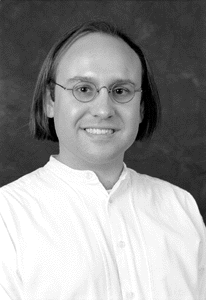|
|
Hopkins Researcher Mines the Secrets of Nanoporous GoldBrawny microscopes, modeling help explain spongelike structure
By Phil Sneiderman |

Dip a chunk of a gold and silver alloy into acid, and the silver quickly dissolves. This process--called dealloying--leaves behind an unusual form of gold whose surface is filled with near-atomic size nooks and crannies, giving it a spongelike appearance when viewed through a high-powered microscope. Why dealloyed gold adopts this odd structure has long puzzled scientists.
Now, researchers, writing in the journal Nature, say they've solved this materials science mystery. By capturing near-atomic scale images of the metal with a scanning electron microscope and by constructing computer models of the dealloying process, the researchers produced a series of mathematical equations describing how the porous gold evolves.
In their report, published in the March 22 issue, the scientists also present a theory to explain why the dealloyed gold does not return to the dense crystalline form that is commonly used by jewelry-makers.
"As the silver atoms in the alloy are dissolved by the acid, the remaining atoms of gold gather together in clusters that create a rough surface, rather than a smooth one, causing the gold to evolve into a porous material," explains Jonah Erlebacher, assistant professor of materials science and engineering at Johns Hopkins and lead author of the report. "We believe this is related to the nature of the interface--the place where the acid makes contact with the surface of the alloy. Picture what happens when you spray water onto a pane of glass. Instead of forming a uniform coating on the glass, the water collects into beads on the surface. Our research leads us to believe the dealloyed gold atoms act like water droplets, condensing into little clumps that grow into the backbone of a porous structure."
 |
| Jonah Erlebacher |
The team's findings could have important ramifications. Because of their microscopic hills and ravines, nanoporous metals have a much larger surface area than an equal volume of nonporous material. "A large surface area is the primary quality you look for in a good catalyst, which is a material that facilitates a chemical reaction," Erlebacher says. "If a chemical reaction depends on activity that takes place at the surface of the material, then the more surface area you have, the more efficient the reaction will be."
Although gold, an inert metal, is not a good catalyst, its nanoporous form could be coated with catalytic substances, including enzymes, for sensor applications, particularly in biomedical devices, Erlebacher says.
The equations developed by Erlebacher and his colleagues should help scientists chemically tailor nanoporous gold for such purposes. "Understanding equals control," the Hopkins engineer says. "Understanding how to make this material, and why it has the shape it does under certain experimental conditions, gives us the ability to change some of these conditions--the temperature or the strength of the acid, for example--in order to fabricate the metal for particular applications."
The team's research also may help engineers understand why the outer layers of some alloys used in aviation turn porous in a type of corrosion that can lead to mechanical failure.
Understanding how nanoporous gold evolves required technology available only within the last decade, but the dealloying process itself is many centuries old. Ancient Incan metalsmiths stretched their supplies of precious gold by mixing it with copper, then surrounding the alloy with salty substances. This created an acid environment that dissolved the copper from the top layer, leaving a gold-rich surface ready for polishing. This technique is called depletion gilding.
Erlebacher began trying to solve the mysteries of this process as a postdoctoral fellow at Harvard. He finished the work contained in the Nature report after joining the faculty of the Whiting School of Engineering last September. The National Science Foundation recently awarded him a CAREER grant that could provide more than $485,000 over the next five years to continue research into the formation and potential use of nanoporous gold.
Erlebacher's co-authors in the Nature report were Michael J. Aziz, a professor at Harvard; Alain Karma, a professor at Northeastern University; Nikolay Dimitrov, a postdoctoral fellow at Arizona State University; and Karl Sieradzki, a professor at Arizona State.
| GO TO MARCH 26, 2001 TABLE OF CONTENTS. |
| GO TO THE GAZETTE HOME PAGE. |